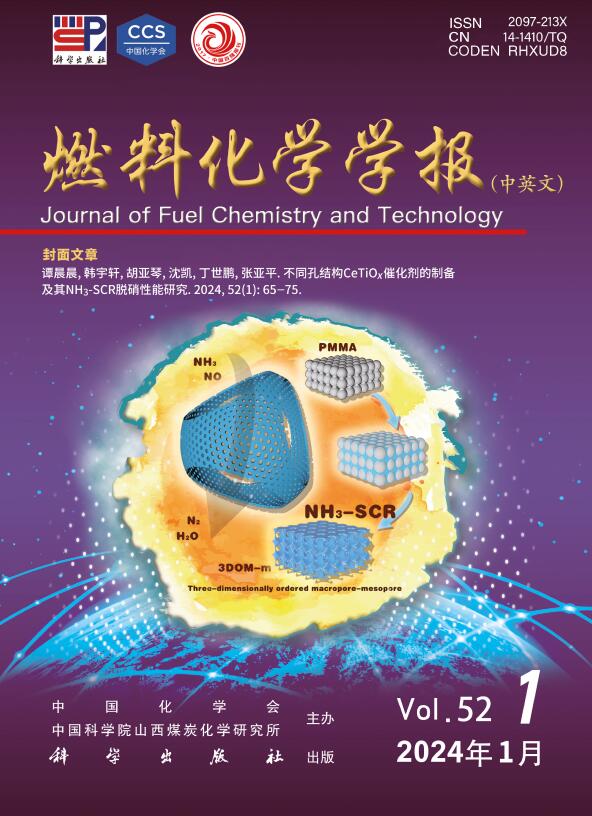Influence of the structure and surface properties of CeZnxO2 on its catalytic performance in the synthesis of dimethyl carbonate from CO2 and methanol
Q3 Energy
引用次数: 0
Abstract
A series of CeZnxO2 catalysts with different Zn doping contents were prepared by a reflux method and used in the direct synthesis of dimethyl carbonate (DMC) from CO2 and methanol; various characterization techniques were employed to investigate the influence of the structure and surface properties on the catalytic performance of CeZnxO2 in the DMC synthesis. The results demonstrate that Zn2+ is incorporated into the CeO2 lattice, forming a solid solution. The Zn/Ce molar ratio can significantly modulate the Ce3+/Ce4+ redox equilibrium in CeZnxO2; with an increase of the Zn doping content, the oxygen vacancy concentration initially rises and then declines. A moderate Zn doping level (Zn/Ce = 0.5) can promote the redox process of 2Ce4+ + Zn0 = 2Ce3+ + Zn2+, resulting in the highest Ce3+ proportion and a substantial increase of the oxygen vacancy concentration. In contrast, excessive Zn doping (Zn/Ce ≥ 0.75) leads to a reduction in both the Ce3+ content and oxygen vacancy concentration. There is a strong positive correlation between the catalytic activity and the number of weak base sites, as well as a linear relationship with the surface oxygen vacancy concentration. In particular, CeZn0.5O2 with a Zn/Ce molar ratio of 0.5 exhibits the best catalytic performance in the DMC synthesis, owing to its high oxygen vacancy concentration and well-balanced distribution of basic sites.
CeZnxO2的结构和表面性质对其催化CO2和甲醇合成碳酸二甲酯性能的影响
采用回流法制备了一系列不同锌掺杂量的CeZnxO2催化剂,用于CO2和甲醇直接合成碳酸二甲酯(DMC);采用多种表征技术考察了CeZnxO2的结构和表面性质对其DMC合成催化性能的影响。结果表明,Zn2+与CeO2晶格结合,形成固溶体。Zn/Ce摩尔比能显著调节CeZnxO2中Ce3+/Ce4+的氧化还原平衡;随着Zn掺杂量的增加,氧空位浓度先上升后下降。适量Zn掺杂(Zn/Ce = 0.5)可促进2Ce4+ + Zn0 = 2Ce3+ + Zn2+的氧化还原过程,Ce3+比例最高,氧空位浓度大幅增加。过量的Zn掺杂(Zn/Ce≥0.75)导致Ce3+含量降低,氧空位浓度降低。催化活性与弱碱位数呈正相关,与表面氧空位浓度呈线性关系。其中,Zn/Ce摩尔比为0.5的CeZn0.5O2由于氧空位浓度高、碱性位分布均匀,在DMC合成中表现出最好的催化性能。
本文章由计算机程序翻译,如有差异,请以英文原文为准。
求助全文
约1分钟内获得全文
求助全文
来源期刊

燃料化学学报
Chemical Engineering-Chemical Engineering (all)
CiteScore
2.80
自引率
0.00%
发文量
5825
期刊介绍:
Journal of Fuel Chemistry and Technology (Ranliao Huaxue Xuebao) is a Chinese Academy of Sciences(CAS) journal started in 1956, sponsored by the Chinese Chemical Society and the Institute of Coal Chemistry, Chinese Academy of Sciences(CAS). The journal is published bimonthly by Science Press in China and widely distributed in about 20 countries. Journal of Fuel Chemistry and Technology publishes reports of both basic and applied research in the chemistry and chemical engineering of many energy sources, including that involved in the nature, processing and utilization of coal, petroleum, oil shale, natural gas, biomass and synfuels, as well as related subjects of increasing interest such as C1 chemistry, pollutions control and new catalytic materials. Types of publications include original research articles, short communications, research notes and reviews. Both domestic and international contributors are welcome. Manuscripts written in Chinese or English will be accepted. Additional English titles, abstracts and key words should be included in Chinese manuscripts. All manuscripts are subject to critical review by the editorial committee, which is composed of about 10 foreign and 50 Chinese experts in fuel science. Journal of Fuel Chemistry and Technology has been a source of primary research work in fuel chemistry as a Chinese core scientific periodical.
 求助内容:
求助内容: 应助结果提醒方式:
应助结果提醒方式:


